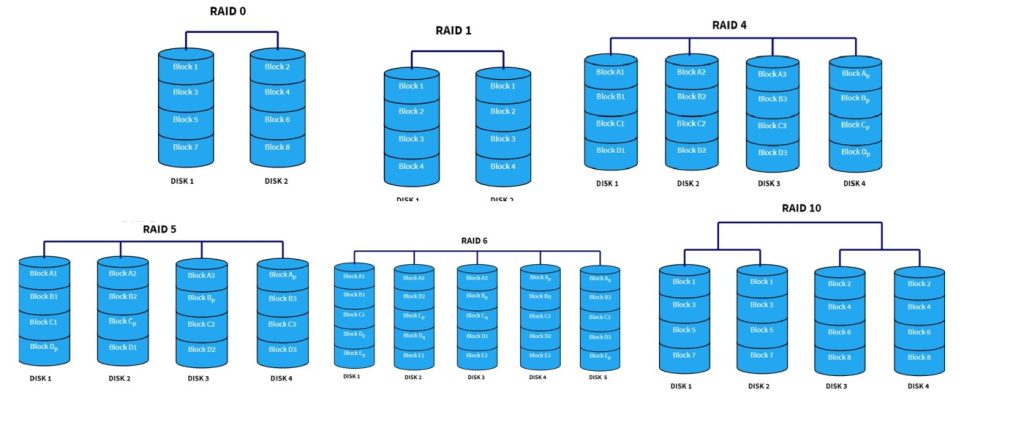RAID (Redundant Array of Independent Disks) is a data storage technology that combines multiple disk drive components into a logical unit for the purpose of data redundancy or performance improvement.
RAID arrays are used to improve the performance, reliability, and capacity of storage systems. They do this by distributing data across multiple disk drives, which allows for faster data access and improved fault tolerance.

There are several different types of RAID configurations, known as RAID levels, which differ in terms of the way they store data and the level of redundancy they provide. Some common RAID levels include:
RAID 0: Striping. Data is striped across multiple disks, which can improve performance by allowing multiple disks to be accessed simultaneously. However, there is no redundancy, so a single disk failure will result in data loss.
RAID 1: Mirroring. Data is mirrored across multiple disks, providing complete redundancy in the event of a single disk failure. However, this can reduce performance as all writes must be written to multiple disks.
RAID 4: RAID 4 is a type of RAID configuration that uses striping (splitting data across multiple disks) and a dedicated parity disk (a disk used for storing error-correcting data).
In a RAID 4 configuration, data is striped across all disks in the array, except for the dedicated parity disk. This means that if one of the disks fails, the data can be reconstructed using the data on the remaining disks and the parity information stored on the dedicated parity disk. However, because all read and write operations require access to the parity disk, RAID 4 can have slower performance compared to other RAID configurations, such as RAID 0 or RAID 1.
RAID 4 is not a commonly used RAID configuration due to its relatively slow performance and the availability of faster and more flexible alternatives, such as RAID 5 and RAID 6.
RAID 5: Striping with parity. Data is striped across multiple disks, with parity information distributed across all disks. This provides some level of redundancy, as the array can recover from a single disk failure. However, the parity calculation can impact performance.
RAID 6: Striping with dual parity. Similar to RAID 5, but with an additional level of parity. This provides even more redundancy, but at the cost of even higher parity calculations and reduced performance.
RAID 10: Striping and mirroring. A combination of RAID 0 and RAID 1, providing both improved performance and redundancy.

There are other RAID levels as well, such as RAID 2, 3, and 4, but these are less commonly used.
In summary, RAID arrays provide a way to improve the performance, reliability, and capacity of storage systems by distributing data across multiple disks and providing various levels of redundancy.